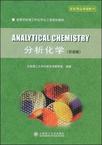分析化学
出版时间:2008-11 出版社:大连理工大学出版社 作者:大连理工大学分析化学教研室 编著 页数:3147
前言
分析化学是人们获得物质组成、结构和信息的科学,即表征和测量的科学。现代分析化学已远远超出化学学科的领域,正逐步将化学与数学、物理学、计算机科学、生物学等学科结合起来,发展成为一门综合性科学。该学科的快速发展促使分析化学课程不断更新,从而确保学生可以掌握最新的分析化学发展动态。 分析化学是高等理工科院校化学、化工及相关专业的一门基础课。在保证教学要求的基础上,既要使学生理解和掌握教学内·容,对课程整体及学科发展前沿有所了解,又要扩展学生的知识面,提高专业水平。教育部提出的双语教学模式已成为培养高素质人才的有效措施之一。 由大连理工大学国家精品课程建设团队——分析化学教研室组编的“分析化学”(双语版)教材正是对教育部提出的关于在高等院校一些专业按一定比例开设双语课程的积极响应。编者不仅长期工作在本科生分析化学教学第一线,而且具有多年从事双语教学的经验。即将出版的分析化学(双语版)教材也是在多年使用、数次更新的自编讲义基础上编写的,具有很好的前期积累。 目前,国内分析化学专业的双语教材还比较少。编者的工作对即将开展或已经开始从事分析化学双语教学的高校具有很好的借鉴作用。相信本教材的出版会在一定程度上促进国内分析化学双语教学工作的开展,并为提高本科生的专业英语水平起到积极的推动作用。
内容概要
本教材在章节顺序和内容安排上参照了《分析化学》(第三版,大连理工大学分析化学教研室组编,刘志广主编)中文教材,将众多分析方法按大类编写,同时加强仪器分析内容,突出工科特点,在符合发展趋势及社会需要的同时重视学习的规律和逻辑性。英文内容以高等学校化学化工专业本科生少学时分析化学课程教学大纲为依据,参考多种国外原版教材,以使语言表述准确、地道。为使学生在习惯用英文进行专业思考的同时,又熟悉相应的中文用语,在每章末列出该章用到的主要专业名词的中文解释,以及用中文书写的重点内容概述。
书籍目录
Chapter 1 Introduction 绪论 1.1 The nature of analytical chemistry 分析化学的性质 1.2 The role of analytical chemistry 分析化学的作用 1.3 The classification of analytical chemistry分析化学的分类 1.4 The total analytical process分析全过程 Terms to understand 重点内容概述Chapter 2 Errors and Data Treatment in Quantitative Analysis 定量分析中的误差及数据处理 2.1 Fundamental terms of errors误差的基本术语 2.2 Types of errors in experimental data实验数据中的误差类型 2.2.1 Systematic errors 系统误差 2.2.2 Random errors偶然误差 2.3 Evaluation of analytical data分析数据的评价 2.3.1 Tests of significance显著性检验 2.3.2 Rejecting data可疑值取舍 2.4 Significant figures有效数字 Problems Terms to understand 重点内容概述Chapter 3 Titrimetric Analysis滴定分析法 3.1 General principles基本原理 3.1.1 Relevant terms of titrimetric analysis滴定分析相关术语 3.1.2 The preparation of standard solution and the expression of concentration 标准溶液的配制与浓度表示方法 3.1.3 The types of titrimetric reactions滴定反应类型 3.2 Acid-base titration酸碱滴定 3.2.1 Acid-base equilibria 酸碱平衡 3.2.2 Titration curves滴定曲线 3.2.3 Acid-base indicators酸碱指示剂 3.2.4 Applications of acid-base titration酸碱滴定的应用 3.3 Complexometric titration配位滴定 3.3.1 Metal-chelate complexes金属螯合物 3.3.2 EDTA 乙二胺四乙酸 3.3.3 EDTA titration curves EDTA滴定曲线 3.3.4 Metal Ion indicators金属离子指示剂 3.3.5 Applications of EDTA titration techniques EDTA滴定方法的应用 3.4 Oxidation-reduction titration氧化还原滴定 3.4.1 Redox reactions氧化还原反应 3.4.2 Rate of redox reactions氧化还原反应的速率 3.4.3 Titration curves滴定曲线 3.4.4 Redox indicators氧化还原指示剂 3.4.5 Applications of redox titrations氧化还原滴定的应用 3.5 Precipitation titration沉淀滴定 3.5.1 Precipitation reactions沉淀滴定反应 3.5.2 Titration curves滴定曲线 3.5.3 End-point detection终点检测 Problems Terms to understand 重点内容概述Chapter 4 Potentiometry 电位分析法 4.1 Introduction简 介 4.1.1 Classes and characteristics分类及性质 4.1.2 Definition定 义 4.2 Types of potentiometric electrodes电极种类 4.2.1 Reference electrodes 参比电极 4.2.2 Indicator electrodes指示电极 4.2.3 Electrode response and selectivity电极响应及选择性 4.3 Potentiometric methods and application电位法及应用 4.3.1 Direct potentiometric measurement 直接电位法 4.3.2 Potentiometric titrations电位滴定 4.3.3 Applications of potentiometry 电位法应用 Problems Terlns to understand 重点内容概述Chapter 5 Chromatography色谱法 5.1 An introduction to chromatographic methods色谱法概述 5.2 Fundamental theory of gas chromatography气相色谱基本原理 5.2.1 Plate theory塔板理论 5.2.2 Kinetic theory(rate theory) 速率理论 5.2.3 The resolution Rs as a measure of peak separation 分离度 5.3 Gas chromatography 气相色谱 5.3.1 Components of a gas chromatograph 气相色谱仪的组成 5.3.2 Stationary phases for gas-liquid chromatography 气液色谱固定相 5.3.3 Applications of gas-liquid chromatography 气液色谱的应用 5.3.4 Adsorption chromatography 吸附色谱 5.4 High performance liquid chromatography 高效液相色谱 5.4.1 Instrumentation 仪器组成 5.4.2 High-performance partition chromatography 高效分配色谱 5.5 Miscellaneous separation methods 其他分离方法 5.5.1 High-performance ion-exchange chromatography 高效离子交换色谱 5.5.2 Capillary electrophoresis 毛细管电泳 5.5.3 Planar chromatography 平板色谱 Problems Terms to understand 重点内容概述Chapter 6 Atomic Absorption Spectrometry原子吸收光谱分析法 6.1 Introduction 概述 6.2 Principles 原理 6.2.1 The process of AAS,resonance line and absorption line 原子吸收光谱法的过程,共振线及吸收线 6.2.2 The number of ground atom and the temperature of flame 基态原子数与光焰温度 6.2.3 Quantitative analysis of AAS原子吸收光谱定量分析 6.3 Instrumentation 仪 器 6.3.1 Primary radiation sources 光源 6.3.2 Atomizer 原子仪器 6.3.3 Optical dispersive systems 分光系统 6.3.4 Detectors 检测器 6.3.5 Signal measurements 信号测量 6.4 Quantitative measurements and interferences 定量测定及干扰 6.4.1 Quantitative measurements 定量测定 6.4.2 Interferences 干扰 6.4.3 Sensitivity 6.5 Applications of AAS原子吸收光谱法的应用 Problems Terms to understand 重点内容概述Chapter 7 Ultraviolet and Visible Spectrophotometry 紫外-可见分光光度法 7.1 Introduction简 介 7.2 Ultraviolet and visible absorption spectroscopy 紫外-可见吸收光谱 7.2.1 Introduction for radiant energy 辐射能简介 7.2.2 Selective absorption of radiation and absorbance spectrum 物质对光的选择性吸收和吸收光谱 7.2.3 Absorbing species and electron transition 吸收物质与电子跃迁 7.3 Law of absorption吸收定律 7.3.1 Lambert-Beer's law朗伯-比尔定律 7.3.2 Absorptivity吸光系数 7.3.3 Apparent deviations from Beer's law对比尔定律的明显偏离 7.4 Instruments仪器 7.5 General types of spectrophotometer分光光度计种类 7.6 Application of UV-Vis absorption spectroscopy 紫外-可见吸收光谱的应用 7.6.1 Application of absorption measurement to qualitative analysis 光吸收测定在定性分析上的应用 7.6.2 Quantitative analysis by absorption measurements 光吸收测量定量分析法 7.6.3 Derivative spectrophotometry 导数分光光度法 Problems Terms to understand 重点内容概述Chapter 8 Infrared Absorption Spectroscopy红外吸收光谱 8.1 Theory of infrared absorption红外吸收基本原理 8.1.1 Dipole changes during vibrations and rotations 振转运动中的偶极距变化 8.1.2 Mechanical model of stretching vibrations 伸缩振动机械模型 8.1.3 Quantum treatment of vibrations 振动的量子力学处理、 8.1.4 Types of molecular vibrations分子振动形式 8.2 Infrared instrument components红外仪器组成 8.2.1 Wavelength selection波长选择 8.2.2 Sampling techniques 采样技术 8.2.3 Infrared spectrophotometers for qualitative analysis 定性分析用红外分光光度计 8.2.4 Other techniques其他技术 8.3 The group frequencies of functional groups in organic compounds 有机化合物官能团的特征频率 8.4 The factors affecting group frequencies 影响基团特征吸收频率的因素 8.4.1 Adjacent groups 邻近基团的影响 8.4.2 Hydrogen bonding 氢键 8.5 Qualitative applications to structural analysis 结构分析的定性应用 Problems Terms to understand 重点内容概述Chapter 9 Nuclear Magnetic Resonance Spectroscopy 核磁共振波谱法 9.1 Theory of nuclear magnetic resonance 核磁共振理论 9.1.1 Quantum description of NMR NMR 的量子描述 9.1.2 Classical description of NMR NMR 的经典描述 9.2 Experimental methods of NMR spectroscopy NMR波谱的实验方法 9.3 The chemical shift of protons in organic compounds 有机化合物中质子的化学位移 9.3.1 Souroe of the chemical shift化学位移产生原 9.3.3 Environmental effects on the chemical shift of proton NMR spectra 影响NMR波谱中质子化学位移的环境因素 9.4 Spin-Spin coupling 自旋-自旋耦合 9.4.1 Source of Spin-Spin coupling and splitting 自旋-自旋耦合与裂分的产生原因 9.4.2 Coupling constant耦合常数 9.4.3 Rule8 governing the interpretation of spectra光谱解析规则 9.5 Qualitative applications of proton NMR质子NMR波谱的定性应用 Problems Terms to understand 重点内容概述Chapter 10 Mass Spectrometry质谱法 10.1 The principle of mass spectroscopy and mass spectrometer 质谱法和质谱仪的原理 10.2 Mass spectra质谱图 10.2.1 The electron impact ionization process 电子轰击离子过程 10.2.2 The molecular ion 分子离子 10.2.3 Isotope peaks 同位素离子峰 10.2.4 Peaks for collision products 碎片离子峰 10.2.5 The base peak 基峰 10.3 Qualitative applications of mass spectroscopy 质谱法的定性应用 Problems Terms to understand 重点内容概述Appendix 附录References 参考文献
图书封面
评论、评分、阅读与下载
用户评论 (总计13条)
- 我们的教材来的,国内少有的英文分析化学教材,内容嘛,跟很多国内教材的章节顺序排版不同,学校老师其实也是拿着上面的话照着我们学校的中文教材的知识点顺序讲的,因为中英版教材的符号还有各个知识点侧重都不一样,学得挺苦的
- 书薄了点,不过不错,虽然不是全文双语,中文知识重点内容摘要,不过也激发我学习的热情,哈哈
- 简单翻了一下,每章最后有单词表,有中文的重点知识总结,学习之
- 内容详实,有重点内容概述,便于阅读理解。是扩大知识面,提高专业英语水平的好教程。
- 很有参考价值,找寻了好久的好书!
- 还没怎么看吼吼~不过书很不错~
- 这本书还不错,值得一阅
- 不错,非常满意,不多见的英文版图书!
- 很好,还会再来买书的~
- 英文篇幅太多,对于英文水平一般的学者较难
- 有大量的英文,不是一句一译。可以学。
- 就当是学习英语了
- 买了没觉得非常好,有些讲得太浅显了.
